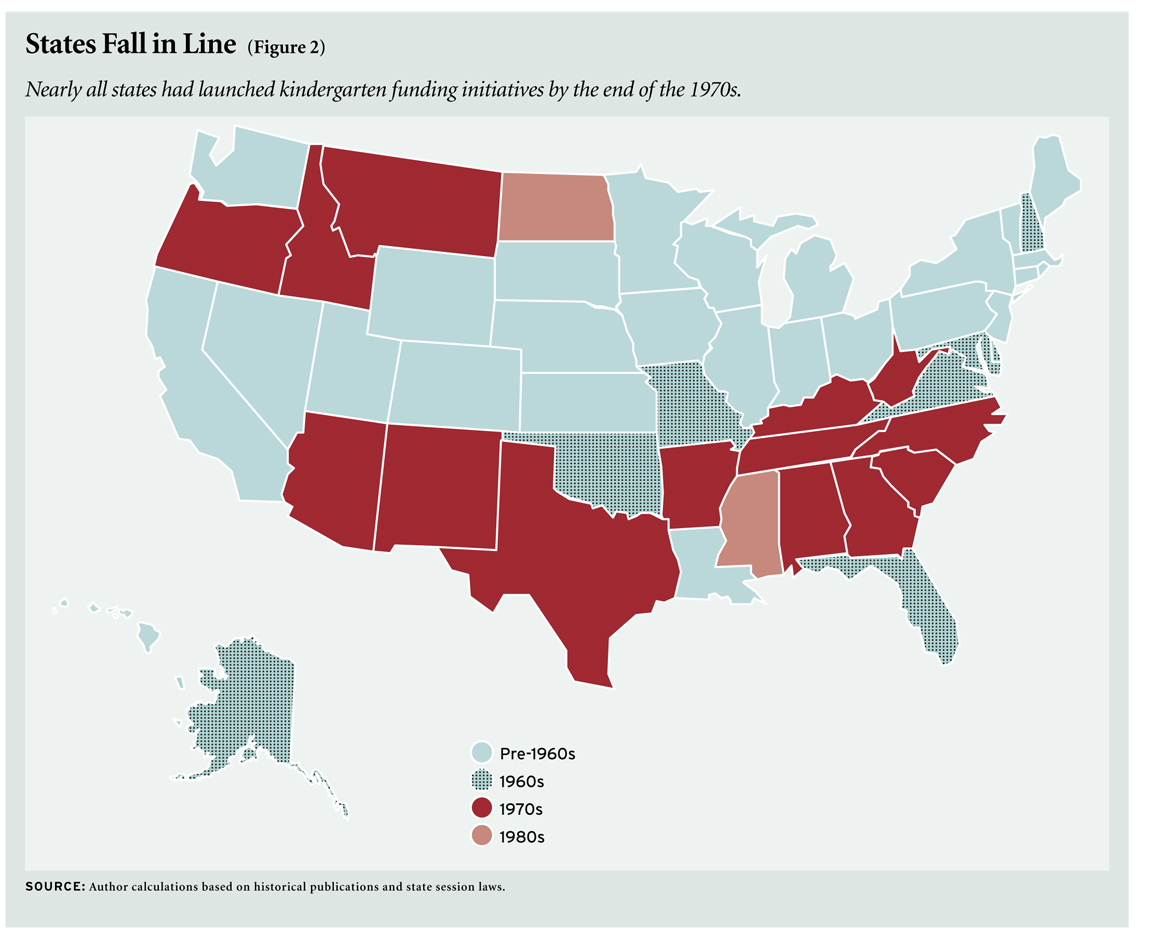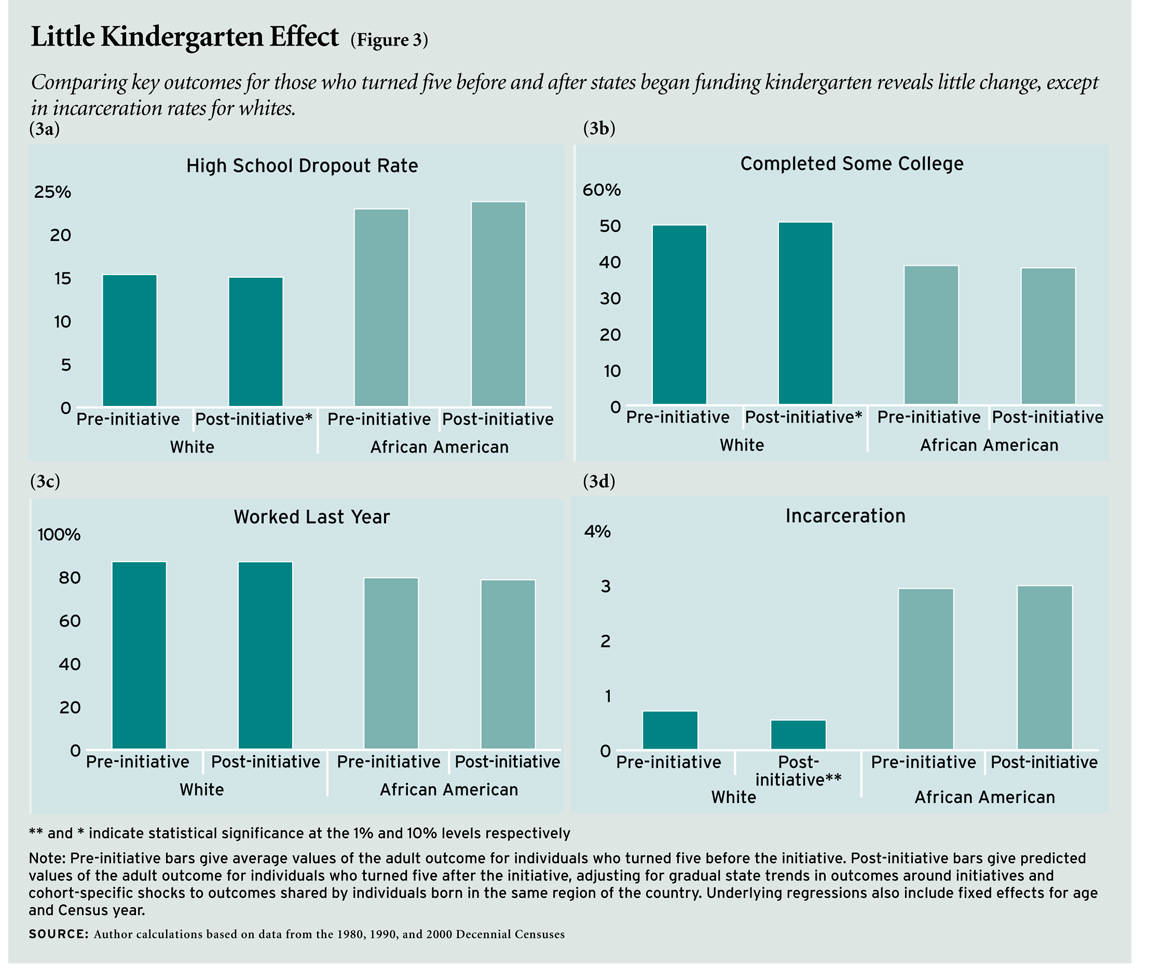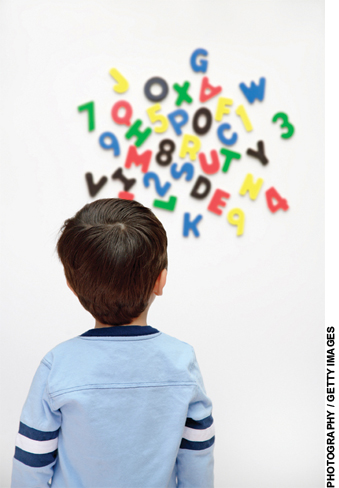 More than four decades after the first model preschool interventions, there is an emerging consensus that high-quality early-childhood education can improve a child’s economic and social outcomes over the long term. Publicly funded kindergarten is available to virtually all children in the U.S. at age five, but access to preschool opportunities for children four years old and younger remains uneven across regions and socioeconomic groups. Parents with financial means have the option of enrolling their child in a private program at their own expense. State and federal subsidies are available to some low-income parents; the federal Head Start program also serves children from low-income families. And states such as Oklahoma and Florida have recently enacted universal preschool programs. Yet gaps in access to high-quality programs remain.
More than four decades after the first model preschool interventions, there is an emerging consensus that high-quality early-childhood education can improve a child’s economic and social outcomes over the long term. Publicly funded kindergarten is available to virtually all children in the U.S. at age five, but access to preschool opportunities for children four years old and younger remains uneven across regions and socioeconomic groups. Parents with financial means have the option of enrolling their child in a private program at their own expense. State and federal subsidies are available to some low-income parents; the federal Head Start program also serves children from low-income families. And states such as Oklahoma and Florida have recently enacted universal preschool programs. Yet gaps in access to high-quality programs remain.
It is unclear whether and how public funds should be mobilized to close those gaps. Some advocate expanding existing programs that target disadvantaged children on the grounds that limited public resources should be directed toward the families and children most in need. Others consider the perennial underfunding of targeted programs like Head Start as evidence of a lack of political support for this approach, and argue that providing universal access is needed to ensure adequate public funding over the long run. In other words, any new funding for preschool education must benefit middle-class children if it is to gain their parents’ political backing. Or so it is argued.
Existing research provides little insight into the relative merits of universal programs and those targeted to specific groups. While there have been several recent studies of the short-term effects of universal preschool programs in the U.S., there is no evidence to date on long-term consequences. Some studies suggest that Head Start has lasting effects in reducing criminal behavior and increasing educational attainment, but this program is much more intensive than any universal program is likely to be and serves a very disadvantaged population.
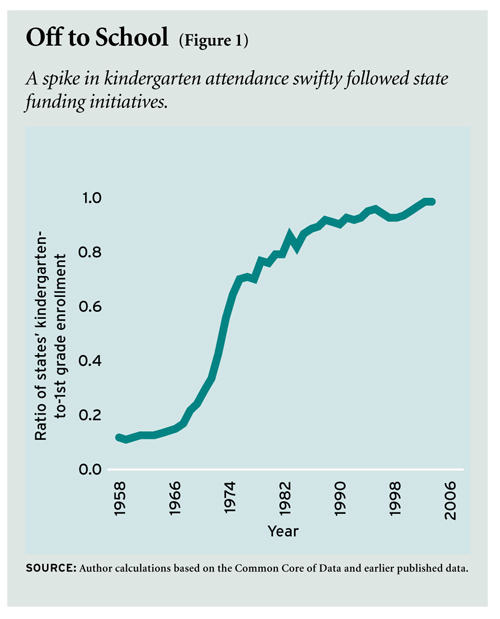 In the absence of direct evidence on the types of preschool programs now under consideration, this study attempts to shed light on the likely consequences of a new universal program by estimating the impact of earlier state interventions to introduce kindergarten into public schools. In the 1960s and 1970s, many states, particularly in the southern and western parts of the country, for the first time began offering grants to school districts operating kindergarten programs. Districts were quick to respond. The average state experienced a 30 percentage point increase in its kindergarten enrollment rate within two years after an initiative, contributing to dramatic increases in kindergarten enrollment (see Figure 1). These interventions present an unusual opportunity to study the long-term effects of large state investments in universal preschool education.
In the absence of direct evidence on the types of preschool programs now under consideration, this study attempts to shed light on the likely consequences of a new universal program by estimating the impact of earlier state interventions to introduce kindergarten into public schools. In the 1960s and 1970s, many states, particularly in the southern and western parts of the country, for the first time began offering grants to school districts operating kindergarten programs. Districts were quick to respond. The average state experienced a 30 percentage point increase in its kindergarten enrollment rate within two years after an initiative, contributing to dramatic increases in kindergarten enrollment (see Figure 1). These interventions present an unusual opportunity to study the long-term effects of large state investments in universal preschool education.
My results indicate that state funding of universal kindergarten had no discernible impact on many of the long-term outcomes desired by policymakers, including grade retention, public assistance receipt, employment, and earnings. White children were 2.5 percent less likely to be high school dropouts and 22 percent less likely to be incarcerated or otherwise institutionalized as adults following state funding initiatives, but no other effects could be discerned. Also, I find no positive effects for African Americans, despite comparable increases in their enrollment in public kindergartens after implementation of the initiatives. These findings suggest that even large investments in universal early-childhood education programs do not necessarily yield clear benefits, especially for more disadvantaged students.
Kindergarten in the U.S.
Many state governments have only recently introduced state grants for school districts that operate kindergarten programs. Kindergartens began outside of the public school system, funded largely through philanthropic organizations or private tuition. Over the first half of the 20th century, kindergartens slowly became incorporated into urban schools, at the same time gaining partial funding through local taxes. As late as the mid-1960s, however, such programs continued to rely heavily on local resources, as only 26 states and the District of Columbia helped fund kindergarten costs. There were remarkable changes over the next decade, however: Between 1966 and 1975, 19 states began funding kindergarten for the first time. The majority of these states were in the South, but the West was also well represented. By the late 1970s, only two states—Mississippi and North Dakota—did not fund kindergarten programs (see Figure 2).
Initially, states channeled their funding to districts in one of two ways. Some states revised existing funding formulas to include financial support for kindergartens on a basis equivalent to support for all other grades in a state’s public school system. Other states appropriated separate monies for kindergarten, an approach that made kindergarten funding more vulnerable to budget cuts. Eventually, however, all states made kindergarten a part of the basic state school program.
The initiatives were introduced during a period of rising labor-force participation among women with young children, so kindergarten’s popularity may have been due to the fact that it provided families with subsidized child care. The stated purpose, however, was to improve children’s educational outcomes. In particular, it was claimed that kindergarten would provide the preparation children need to succeed in the elementary school years. Greater success in school would, in turn, reduce state spending not only on special education and “re-education” of children who failed, but also on public assistance and incarceration over the long term.
Whether state funding of kindergarten was capable of achieving these goals is open to question. Kindergartens have historically maintained a curriculum focused more on children’s social development and less on academic training. While a focus on socialization does not preclude long-term effects, kindergarten programs lacked features of some targeted interventions—such as parental involvement and health services—that may be critical to their success. State-funded kindergartens for five-year-olds may also have reduced enrollment in private kindergartens and in education programs funded through Head Start and Title I. My study seeks to shed light on these important policy questions of relevance to the current conversations concerning early childhood education.
Method and Data
To find out the long-term impacts of the introduction of universal kindergarten, I take advantage of the staggered introduction of state funding for kindergarten from the 1960s forward, combined with the fact that children generally attend kindergarten at age five. More specifically, I calculate the average difference in outcomes between individuals who were age five before the introduction of kindergarten funding and children born in the same state who were five years old after the initiative was introduced. I further adjust these comparisons to take into account the fact that kindergarten enrollment was increasing gradually in many states prior to the adoption of state funding. The remaining differences should reflect the long-run effects of the typical state-funded kindergarten program.
I restrict my analysis to the 24 states that introduced state funding for universal kindergarten after 1960 because the data needed for the analysis are not available for earlier years. I also limit attention to the 1954 to 1978 birth cohorts because they span the period over which most of these funding initiatives were passed, and doing so provides me with data both before and after the introduction of these initiatives necessary to estimate the effects of kindergarten funding on long-term outcomes.
I combine data from several sources. I measure the kindergarten enrollment rate with the state kindergarten-to-first-grade enrollment ratio, calculated from the federal Common Core of Data and earlier published data. Data for the analysis of the initiatives’ long-term effects were drawn from Public Use Microdata Samples (PUMS) of the Decennial Census. In particular, I examine 1) whether a child was below grade for age while still of school age (a proxy for grade retention); 2) three indicators of adult educational attainment (high school dropout, high school degree only, and some college); 3) adult wage and salary earnings and indicators of employment and receipt of public assistance income; and 4) an indicator for residence in institutionalized group quarters, a widely used proxy for incarceration.
Limited Impact
I begin the empirical analysis by examining how the funding initiatives affected kindergarten enrollment. The results confirm that funding had a large, immediate impact on kindergarten participation. In the first year in which funding was available, the kindergarten enrollment rate in the typical state was about 15 percentage points higher than would have been the case in the absence of state funding. Two years out, it was 33 percentage points higher, and the lion’s share of gains in kindergarten enrollment from the funding initiative had been achieved. Anecdotal evidence suggests that the take-up of kindergarten was not completely immediate because of shortages of classrooms and teachers rather than because of a gradual increase in local demand. On net, the public school kindergarten enrollment rate of children turning five after an initiative was about 30 percentage points higher than it would otherwise have been.
I next investigate whether these developments were matched by changes in child well-being. Because grade retention and educational attainment were arguably the prime targets of policymakers, I first consider the effects of kindergarten funding on those indicators. Whites had more education as adults as a result of the initiatives, but the effect was quite small: only a 2.5 percent reduction in the dropout rate (see Figure 3). Because the dropout rate among whites prior to kindergarten funding was roughly 15 percent, this reduction amounts to less than half of 1 percentage point, which is a small effect even if we take into account that kindergarten enrollment rose 30 percentage points (not a full 100 percentage points) as a result of the initiatives. College attendance also increased among whites, but by an even smaller amount. The analogous estimates for African Americans suggest that affected children attained lower levels of education. While not statistically significant, the estimates are sufficiently precise to rule out the possibility that African Americans experienced even the small positive gains in educational attainment evident among whites. The apparent gains in educational attainment for whites occurred without significant reductions in grade repetition, either in absolute terms or relative to African Americans.
I then turn to an investigation of the impacts on earnings, employment, public assistance receipt, and the proxy for incarceration described earlier. I again find little evidence that kindergarten funding affected these outcomes. The most notable exception is that whites of kindergarten age after passage of a funding initiative were less likely to reside in prisons or institutionalized group quarters as adults. The effect is relatively large, at 22 percent. Once again, however, no such effects were observed for African Americans. Moreover, I find no evidence of an impact of state kindergarten funding on earnings for individuals of either race. The estimated effects on earnings are imprecise, however, and leave open the possibility that kindergarten attendance had effects on earnings comparable to any other year of education for African Americans and whites alike. In general, the earnings estimates should be viewed with caution, as they could be distorted by the fact that the sample includes some individuals who are young and could still be enrolled in school.
These results remain essentially unchanged when estimated using to a series of alternative approaches, including adding controls for state demographic and labor market conditions. I also perform the analysis separately by gender, which reveals that the effect of kindergarten funding on institutionalization for whites is primarily due to its effect on men, for whom the institutionalization rate is much higher. The magnitude of the effect for white men is similar to that observed for whites overall (a reduction of 23 percent). Among African Americans, there are no effects on institutionalization rates for men or women. The gender-specific results also reveal that kindergarten funding was associated with significantly lower earnings for African American women. To the extent that kindergarten funding displaced African American enrollment in more intensive early education, a possibility that I explore below, these findings would be consistent with recent findings that girls are more responsive to intensive preschool interventions.
Why Did African Americans Not Benefit?
My main results imply that there were some positive impacts of state subsidization of kindergarten, particularly on incarceration rates. What is potentially unexpected, however, is that the funding initiatives appear to have had positive effects only for whites. What might explain these findings? I explore three broad hypotheses for why African Americans might not have benefited as much as whites from the funding initiatives: 1) kindergarten funding disproportionately drew African Americans out of higher-quality education settings; 2) instead of raising additional revenue to fund local kindergarten programs fully, school districts offered lower-quality kindergarten programs to African Americans or moved funds from existing school programs from which African Americans may have disproportionately benefited; and 3) African Americans were more adversely affected by any subsequent “upgrading” of school curricula as more students entered elementary grades having attended kindergarten. The first of these hypotheses receives the most support in the available data.
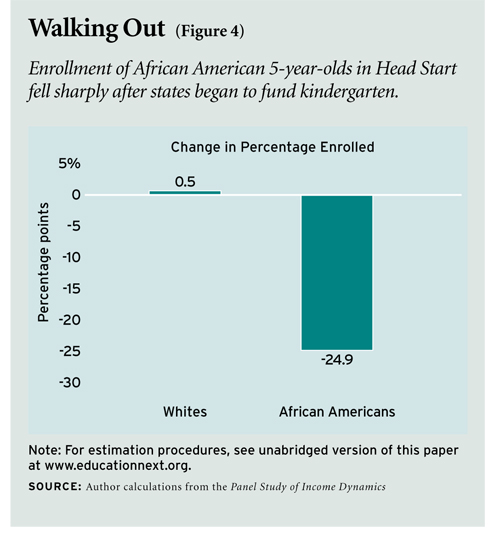 Data from the Panel Study of Income Dynamics suggest that the introduction of state funding for kindergarten prompted a reduction in Head Start participation among African Americans. The existence of kindergarten funding among all states in a region (relative to none) was associated with a statistically significant 25-percentage-point-reduction in the likelihood that an African American child attended Head Start at age five. Given an enrollment rate of 26 percentage points across the observed cohorts, this estimate implies that state funding for kindergartens essentially eliminated enrollment of African American five-year-olds in Head Start (see Figure 4). By comparison, enrollment of whites in Head Start at age five was much lower (2 percent), and the change in enrollment after the average funding initiative close to zero.
Data from the Panel Study of Income Dynamics suggest that the introduction of state funding for kindergarten prompted a reduction in Head Start participation among African Americans. The existence of kindergarten funding among all states in a region (relative to none) was associated with a statistically significant 25-percentage-point-reduction in the likelihood that an African American child attended Head Start at age five. Given an enrollment rate of 26 percentage points across the observed cohorts, this estimate implies that state funding for kindergartens essentially eliminated enrollment of African American five-year-olds in Head Start (see Figure 4). By comparison, enrollment of whites in Head Start at age five was much lower (2 percent), and the change in enrollment after the average funding initiative close to zero.
Together with historical accounts of the importance of Head Start in providing education for five-year-olds in the absence of state-funded kindergartens, these estimates strengthen support for the hypothesis that state funding for kindergartens decreased enrollment of African American five-year-olds in federally funded early education for the poor. It is difficult to gauge the extent to which the movement of African American five-year-olds from Head Start to kindergarten might have offset positive impacts of kindergarten attendance elsewhere in the African American population. However, a back-of-the-envelope calculation suggests that the reduction in Head Start attendance among African Americans may account for at least 16 percent of the 1-percentage-point increase in the African American-white gap in high school dropout rates after the initiatives were passed. Head Start has also been found to reduce criminal behavior among African-American males.
I uncover no support for the hypothesis that school districts failing to supplement the state grants placed African American students in lower-quality programs, either in kindergarten or in later grades. I also detect no evidence that the establishment of kindergarten programs as a result of the funding initiatives prompted an increase in academic expectations of students in the early grades, which would have adversely affected children with low levels of achievement. Because the data available to test these alternative hypotheses are not ideal, however, these conclusions must be viewed with caution.
Back to the Future
Although there is great interest among policymakers in extending free early education to disadvantaged children, evidence to date on long-run effects of preschool has been limited to experimental evaluations of model preschools and nonexperimental studies of Head Start. This study has attempted to expand this literature by measuring the long-term effects of a historical episode of public investment in universal early education—the introduction of state funding for public school kindergarten in the 1960s and 1970s. I find evidence that state funding of universal kindergarten lowered high-school dropout and institutionalization rates among whites, but not among African Americans, and detect no impact of state funding for children of either race on grade retention, public assistance receipt, employment or earnings. Why the positive effects for whites occur for dropout and incarceration only is not entirely clear and should be grounds for future research.
These findings complement those of existing research on the long-term effects of targeted programs. First, they suggest that, in the absence of higher-quality alternatives, participation in a low-intensity preschool program may have some limited positive long-term effects. In other words, even a weak program may be better than no program at all, as can be seen in the results for whites. Second, when alternatives already exist for many disadvantaged children, universal programs may not yield additional benefits for that group.
Though there are clear limits to the generalizability of these findings, they do provide some tentative lessons for policymakers. On one hand, the higher rates of preschool participation among children today suggest that any positive long-term effects of extending universal public schooling to four-year-olds may be even smaller than those estimated here for kindergarten. On the other hand, the universal preschool programs being proposed today have a more academic orientation than kindergarten has had, and may therefore have larger impacts on long-term well-being despite significantly “crowding-out” enrollment in other programs. The truth will only be discovered in the years to come.
Elizabeth U. Cascio is assistant professor of economics at Dartmouth College.


